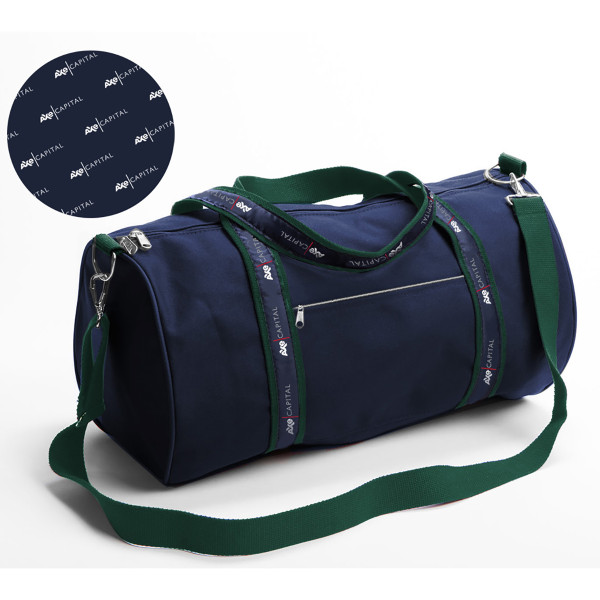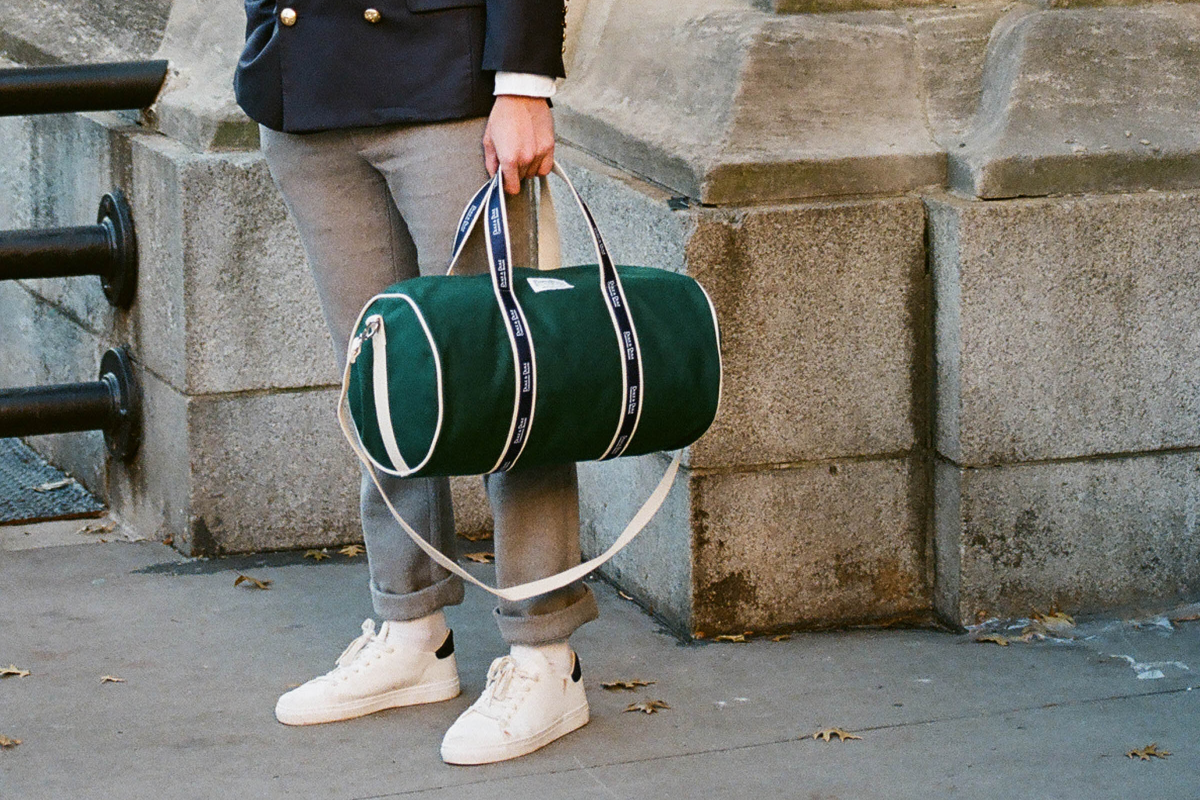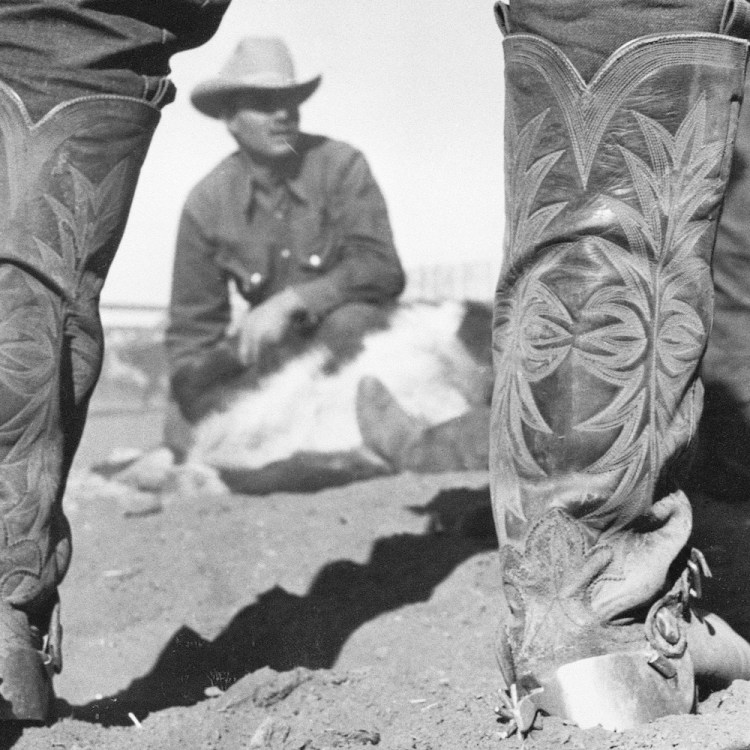You can’t swing a tote bag on a subway car without hitting one. You trip over them at the gym all the time. You will always see a few stashed in the overhead on the Hampton Jitney when you make your way out east.
We’re talking, of course, about that ubiquitous the de facto Midtown Uniform accessory: the Banker Bag. Love em’ or hate em’, those cylindrical canvas bags with pieces of Wall Street branding will never die — and now they are on their way to becoming a fashion staple.
The bags are standard issue for the entry-level analysts, bankers, traders and fund managers who make the money move. And while the firms might be different, “There is only one original Wall Street Banker Bag,” as Warden Brooks proudly declares on their website.
The story of the O.G. banker bag is certainly a successful one. Warden Brooks was started by the then 28-year-old Joan Killian Gallagher in 1978. Looking to get into the Wall Street merch game (a very early adopter!), she wanted to create a status symbol that would become as synonymous with the era as the Rolex or the BMW, but without the huge price tag attached. All you needed to get one was to become a member of the very selective club that is the financial world.
The bag that would send her into Wall Street lore wasn’t anything special, really: just a preppy gym bag perfect for a weekend trip. She called it the “Original Duffel,” tubular in shape and made from heavy-duty 18-oz. dyed-to-match canvas webbing, all constructed in New Canaan, Connecticut, where they are still made today. But when Gallagher received a roll of jacquard woven labels for bags that had yet to be cut, everything changed. “When the first labels were sent to me, they were uncut. At that moment, I thought, ‘This is it. I will use this as woven ribbon trim for the product line I am designing,’” she recounted to the New York Sun in 2003.
Even the name of Gallagher’s company, Warden Brooks, has a perfect fake-it-till-you-make-it origin story.
Wanting the name of her new business to have a smart ring to it, she used her married name and added Brooks as a reference to two streams in her Westchester backyard. “I wanted it to sound established and very British, as though it had been around for 100 years. I wanted to leave the impression that we were a huge conglomerate,” she said.
In the boom years of the 1980s and heady late-’90s, the bag became an institution and Warden Brooks a success. Banks loved the bags, and financial giants like Goldman Sachs, Credit Suisse and Morgan Stanley began giving them out to their new hires, becoming the distinguishing characteristic of first-year associates across the city. They were even considered a good way to suss out whether a guy was worth dating in the pre-Tinder days of early-aughts New York, as evidenced by a Sun article from 2013 that asked single women in the city for their opinions on the bags. “It means he has a good education and a good job,” replied one young woman. “After I see that it’s a good company, I also look to see who it is that works there,” another said.
Banker bags were still around after Black Monday in 1987, the bubble days of the ’90s, the 2008 crash and today iterations from now-defunct companies drive a thriving secondary market on eBay. More than 40 years since they were introduced, the bag is still here.
While the banker bag may be the physical manifestation of “securing the bag” for some, it leaves something to be desired for others. Let’s face it: they are associated with the “Greed is Good” era. That was the time when contrast collars were thought to be a good idea, cell phones were the size of lunch boxes, student-loan debt wasn’t a full-on crisis and you could buy a house at 35. But that isn’t the time we live in today. Now, socialism is “sexy” according to one New York magazine article and dressing like you live in a middle-class Midwestern household in the early ‘90s is in. Couple that with the fact that we’re reaching Gilded Age levels of corporate concentration and a massive wealth gap, and you might get why displaying to the world that you work in the financial industry by way of a canvas bag may not seem like the most fashionable choice.
But times and tastes change, and how we as a culture view certain items tends to evolve. One person who sees a place for the banker bag as an accessory for fans of brands like Supreme and Noah as well as the Brooks Brothers set is Jack Carlson, founder of Rowing Blazers –– a downtown brand that is melding streetwear with WASP culture and in doing so has become the kingpin of the preppy comeback. Rowing Blazers have created two banker bags, both made by the original Warden Brooks.
“I think the banker bag is super cool,” Carlson tells InsideHook. “You can carry it ironically or un-ironically; for most people it is the latter. It hasn’t changed in 40 years.”
The brand’s versions of the bag (which go for $135 each) do not hold any allegiance to a bank or firm; rather, they’re more an homage, with tongue-in-cheek pop culture references. One is emblazoned with the corporate logo of Duke & Duke Commodities Brokers, the fictional firm from the 1983 film Trading Places, while the other is a Pierce & Pierce Mergers and Acquisitions banker bag from the classic American Psycho. Still, Carlson recognizes that there is something ironic about making these bags, and also a little rebellious, enough so that he has gotten hate mail over it.
“I woke up the next morning [after the banker bags dropped] to several very angry emails, but one stands out from this guy –– totally un-ironic –– saying something like ‘how dare you appropriate my culture. I work in the M&A industry,’” Carlson says.

It didn’t matter. The Rowing Blazers banker bags sold out in a matter of hours (don’t worry, they are back in stock now).
Of course, the ironic factor can only go so far. There is something else about the banker bag that solidifies it as an undying classic. It plays into the theme of men’s style since time immemorial: hierarchy and status. Those little repeating names on the straps tell people something about the social and maybe financial status of the person holding the bag. And while there is something a bit funny about a company like Rowing Blazers making them or Showtime selling an Axe Capital banker bag from the show Billions, “It is probably not as subversive as we think it is,” says Carlson. “It is done in that spirit, but in reality, you have to know in order to get the joke.”
This article was featured in the InsideHook newsletter. Sign up now.
























